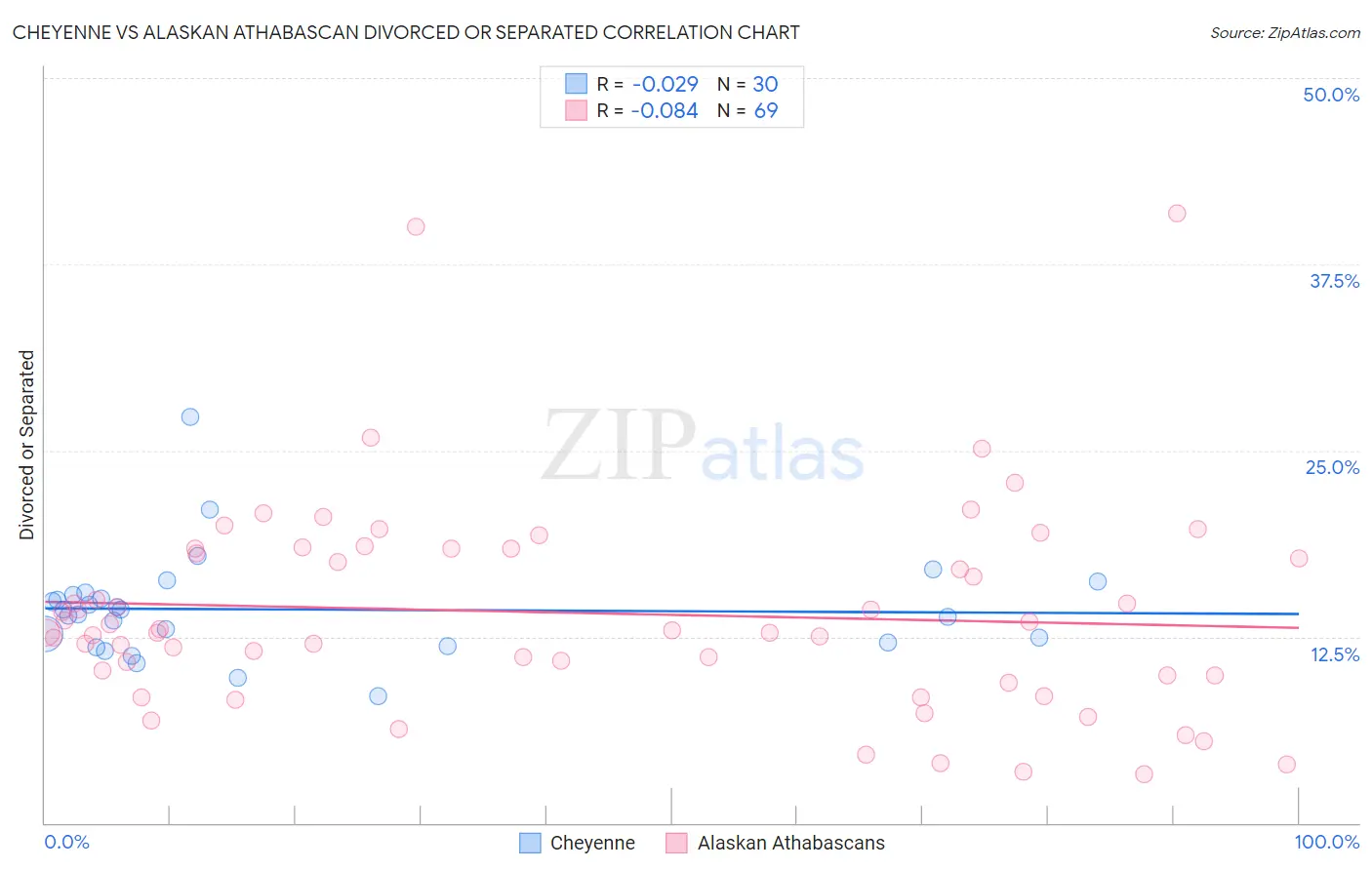Cheyenne vs Alaskan Athabascan Divorced or Separated
COMPARE
Cheyenne
Alaskan Athabascan
Divorced or Separated
Divorced or Separated Comparison
Cheyenne
Alaskan Athabascans
13.4%
DIVORCED OR SEPARATED
0.0/ 100
METRIC RATING
321st/ 347
METRIC RANK
13.1%
DIVORCED OR SEPARATED
0.0/ 100
METRIC RATING
301st/ 347
METRIC RANK
Cheyenne vs Alaskan Athabascan Divorced or Separated Correlation Chart
The statistical analysis conducted on geographies consisting of 80,717,753 people shows no correlation between the proportion of Cheyenne and percentage of population currently divorced or separated in the United States with a correlation coefficient (R) of -0.029 and weighted average of 13.4%. Similarly, the statistical analysis conducted on geographies consisting of 45,819,627 people shows a slight negative correlation between the proportion of Alaskan Athabascans and percentage of population currently divorced or separated in the United States with a correlation coefficient (R) of -0.084 and weighted average of 13.1%, a difference of 1.9%.

Divorced or Separated Correlation Summary
| Measurement | Cheyenne | Alaskan Athabascan |
| Minimum | 8.5% | 3.3% |
| Maximum | 27.2% | 40.9% |
| Range | 18.7% | 37.6% |
| Mean | 14.3% | 14.1% |
| Median | 14.1% | 13.0% |
| Interquartile 25% (IQ1) | 12.1% | 9.9% |
| Interquartile 75% (IQ3) | 15.3% | 18.4% |
| Interquartile Range (IQR) | 3.2% | 8.5% |
| Standard Deviation (Sample) | 3.5% | 7.0% |
| Standard Deviation (Population) | 3.4% | 6.9% |
Demographics Similar to Cheyenne and Alaskan Athabascans by Divorced or Separated
In terms of divorced or separated, the demographic groups most similar to Cheyenne are Cajun (13.4%, a difference of 0.10%), Puget Sound Salish (13.4%, a difference of 0.16%), Cree (13.4%, a difference of 0.20%), Haitian (13.3%, a difference of 0.22%), and Tsimshian (13.3%, a difference of 0.24%). Similarly, the demographic groups most similar to Alaskan Athabascans are Immigrants from Venezuela (13.1%, a difference of 0.10%), Cape Verdean (13.1%, a difference of 0.12%), Hopi (13.2%, a difference of 0.25%), Chippewa (13.2%, a difference of 0.30%), and Tlingit-Haida (13.2%, a difference of 0.46%).
| Demographics | Rating | Rank | Divorced or Separated |
| Alaskan Athabascans | 0.0 /100 | #301 | Tragic 13.1% |
| Immigrants | Venezuela | 0.0 /100 | #302 | Tragic 13.1% |
| Cape Verdeans | 0.0 /100 | #303 | Tragic 13.1% |
| Hopi | 0.0 /100 | #304 | Tragic 13.2% |
| Chippewa | 0.0 /100 | #305 | Tragic 13.2% |
| Tlingit-Haida | 0.0 /100 | #306 | Tragic 13.2% |
| French American Indians | 0.0 /100 | #307 | Tragic 13.2% |
| Ottawa | 0.0 /100 | #308 | Tragic 13.2% |
| Americans | 0.0 /100 | #309 | Tragic 13.2% |
| Africans | 0.0 /100 | #310 | Tragic 13.2% |
| Sioux | 0.0 /100 | #311 | Tragic 13.2% |
| Blackfeet | 0.0 /100 | #312 | Tragic 13.3% |
| Immigrants | Nicaragua | 0.0 /100 | #313 | Tragic 13.3% |
| Yaqui | 0.0 /100 | #314 | Tragic 13.3% |
| Spanish Americans | 0.0 /100 | #315 | Tragic 13.3% |
| Tsimshian | 0.0 /100 | #316 | Tragic 13.3% |
| Haitians | 0.0 /100 | #317 | Tragic 13.3% |
| Cree | 0.0 /100 | #318 | Tragic 13.4% |
| Puget Sound Salish | 0.0 /100 | #319 | Tragic 13.4% |
| Cajuns | 0.0 /100 | #320 | Tragic 13.4% |
| Cheyenne | 0.0 /100 | #321 | Tragic 13.4% |